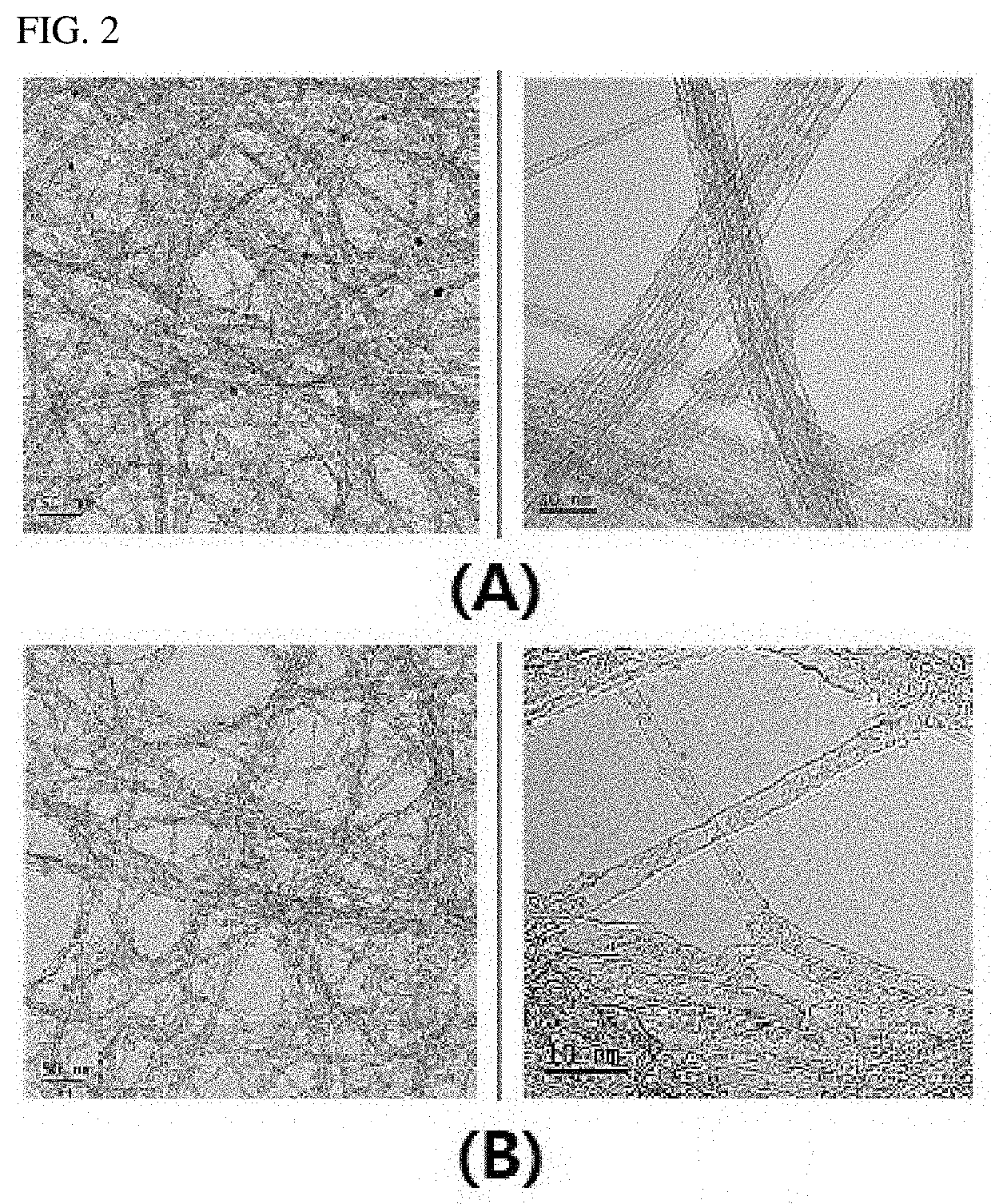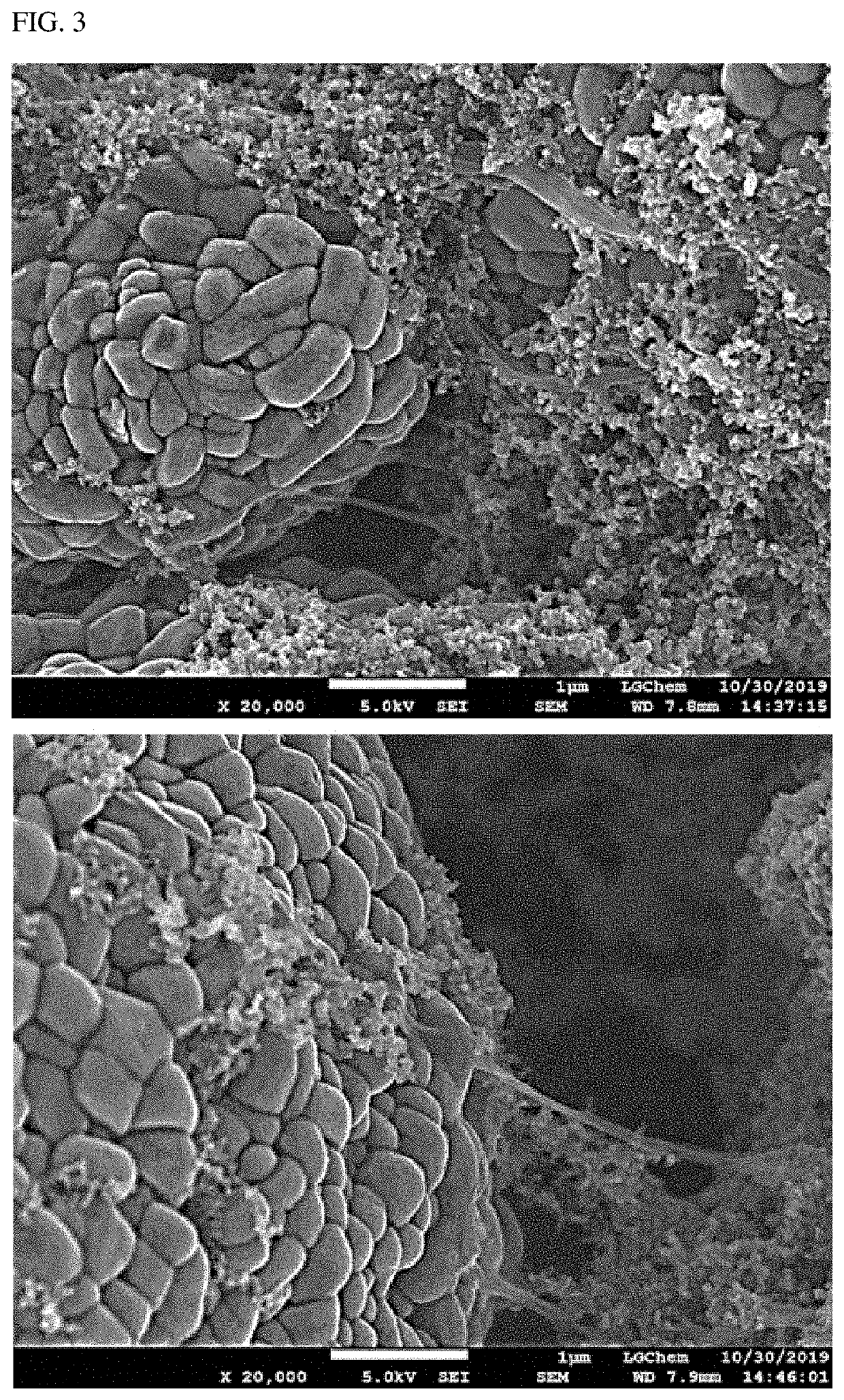Electrode and Secondary Battery Including Same
a secondary battery and electrode technology, applied in the field of electrodes and secondary batteries, can solve the problems of high resistance of the battery, damage to the walled carbon nanotube unit, and difficulty in maintaining a conductive network in the active material layer of the electrode, so as to achieve the effect of improving energy density and life characteristics of the battery, conductive network, and maintaining a low resistance of the electrod
- Summary
- Abstract
- Description
- Claims
- Application Information
AI Technical Summary
Benefits of technology
Problems solved by technology
Method used
Image
Examples
preparation example 1
type Conductive Agent Dispersion
[0108]A carbon black (diameter: 50 nm) having a specific surface area of 240 m2 / g and hydrogenated nitrile butadiene rubbers (weight-average molecular weight: 260,000 g / mol) were mixed with N-methylpyrrolidone (NMP) that is a solvent to prepare a mixture having a solid content of 16.5 wt %.
[0109]The mixture was stirred in a bead-mill method, and bundle-type carbon nanotubes were dispersed in the solvent to prepare a conductive agent dispersion. In this case, the diameter of the beads was 1 mm, the revolution speed of the agitation container containing the beads was 3,000 RPM, and the stirring was performed for 60 minutes.
[0110]In the conductive agent dispersion, an amount of the carbon black was 15 wt %, and an amount of the hydrogenated nitrile butadiene rubbers was 1.5 wt %.
preparation example 2
Nanotube Structure Dispersion
[0111]Bundle-type single-walled carbon nanotubes (having a specific surface area of 650 m2 / g) composed of single-walled carbon nanotube units (having an average diameter of 1.5 nm) and polyvinylidene fluoride (PVdF, KF9700, weight-average molecular weight: 580,000 g / mol) were mixed in N-methyl pyrrolidone (NMP) that is a solvent to prepare a mixture so that a solid content was 2.4 wt %.
[0112]The mixture was stirred in a bead-mill method, and thus the bundle-type single-walled carbon nanotubes were dispersed in the solvent to prepare a carbon nanotube structure dispersion. In this case, the diameter of the beads was 1 mm, the revolution speed of the agitation container containing the beads was 3,000 RPM, and the stirring was performed for 60 minutes. The carbon nanotube structure dispersion included a carbon nanotube structure having a form in which 2 to 5,000 single-walled carbon nanotube units were bonded side by side (see (A) of FIG. 2).
[0113]In the ca...
preparation example 3
Nanotube Structure Dispersion
[0114]In Preparation Example 2, polyvinylidene fluoride having a weight-average molecular weight of 680,000 g / mol was used instead of the polyvinylidene fluoride having a weight-average molecular weight of 580,000 g / mol to prepare a carbon nanotube structure dispersion containing carbon nanotube structures having an average length of 20 μm.
PUM
| Property | Measurement | Unit |
|---|---|---|
| length | aaaaa | aaaaa |
| diameter | aaaaa | aaaaa |
| diameter | aaaaa | aaaaa |
Abstract
Description
Claims
Application Information
 Login to View More
Login to View More - R&D
- Intellectual Property
- Life Sciences
- Materials
- Tech Scout
- Unparalleled Data Quality
- Higher Quality Content
- 60% Fewer Hallucinations
Browse by: Latest US Patents, China's latest patents, Technical Efficacy Thesaurus, Application Domain, Technology Topic, Popular Technical Reports.
© 2025 PatSnap. All rights reserved.Legal|Privacy policy|Modern Slavery Act Transparency Statement|Sitemap|About US| Contact US: help@patsnap.com



